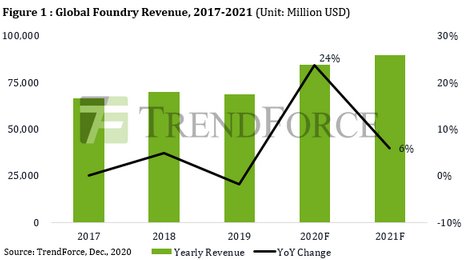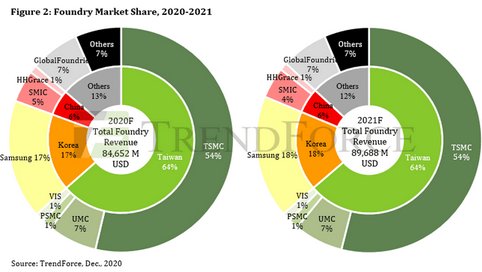Foundry Revenue Expected to Reach New High in 2021 with Close to 6% YoY Growth as Capacities Remain Scarce Across Industry, Says TrendForce
December 29, 2020 -- Global foundry revenue is expected to reach US$84.6 billion in 2020 by undergoing a 23.7% YoY growth, which is the highest % growth in nearly 10 years, according to TrendForce’s latest investigations. This performance took place on the backs of several developments, including OEMs’ aggressive inventory procurement brought about by the COVID-19 pandemic and the “new normal” involving WFH and distance education in 1H20. The second half of the year, on the other hand, saw U.S. sanctions tilting forward Huawei’s component demand, as well as the increased penetration rate of 5G smartphones and increased 5G base station build-outs.
TrendForce has made the following three assumptions regarding foundry demand in 2021: First, pandemic-induced demand for networking products and from the stay-at-home economy will persist somewhat due to uncertainties in the vaccine’s efficacy and side effects. Second, the China-U.S. trade war will remain unresolved. Finally, the global economy will recover in 2021 after the yearlong downturn in 2020. The demand for components will likely rise thanks to not only a forecasted 2-9% growth in the smartphone, server, notebook computer, TV, and automobile markets next year, but also the continued rollout of next-generation networks, including 5G base stations and WiFi 6 technologies. Therefore, the foundry industry is expected to reach its highest revenue ever by growing 6% YoY in 2021.
While foundries accelerate their capacity expansion efforts for advanced processes ahead of 2022, tight supply of 8-inch wafers remains unresolved
With regards to the state of client orders, TSMC’s capacity utilization rate for advanced processes 5nm and below is about 90%, as U.S. sanctions barred Huawei subsidiary HiSilicon from ordering wafer starts, while 5nm wafer starts from Apple, which is TSMC’s primary client at the 5nm node, are unable to fully make up for the absence of HiSilicon. As for TSMC’s 7nm node and Samsung’s 7/5nm nodes, the two foundries are seeing high demand from AMD/MediaTek and Nvidia/Qualcomm, respectively, in turn ensuring nearly fully loaded capacities at these nodes, likely to persist through 2Q20.
Looking ahead from 2H21 to 2022, both TSMC and Samsung have made plans to aggressively expand their 5nm capacities in response to their HPC clients’ high demand for components in 2022. Although wafer starts for most of these clients will generally ramp up from late-2021 to 2022, meaning the two foundries’ capacity utilization rates for the 5nm process may take a slight dip in 2H21, TrendForce believes that production capacities for advanced processes will once again be in severe shortage in 2022 given the rapid growth of the HPC market and the increased orders from Intel, which is accelerating the outsourcing of its production.
Furthermore, TrendForce has observed that OEMs have been aggressive procuring components used in various end-products, including CIS, TDDI, RF front-end, TV chip, WiFi, Bluetooth, and TWS components. This demand momentum, combined with emergent applications such as WiFi 6 chips and heterogeneous integration for AI Memory, as well as the fact that certain products (PMICs and DDICs) are slowly migrating to 12-inch fab manufacturing, means 12-inch fab capacities have been in shortage for the 90-14nm nodes, which are relatively mature processes, as well.
With regards to 8-inch wafers, most foundries currently are able to increase their manufacturing efficiencies to a limited degree only by using their existing fab spaces, improving equipment that presents a bottleneck, or leasing second-hand machines. As well, the arrival of the 5G era has brought about a corresponding explosive growth in PMIC demand due to the proliferation of 5G smartphones and base stations, in turn leading to a short supply of 8-inch wafer capacities. Although foundries are gradually transitioning the manufacturing of certain products, such as the aforementioned PMICs and DDICs, to 12-inch fabs, the tight supply of 8-inch capacities is unlikely to be alleviated in the short run.
Recent escalations in the U.S.-China trade dispute could lead to more severe supply crunch in foundry market by 2H21
The other key factor influencing the shift in production capacities across the foundry industry is U.S. sanctions against SMIC. TrendForce indicates that Broadcom and Qualcomm are SMIC’s major clients from the U.S. Since the news broke on September 10 that the U.S. government was planning to put SMIC on the Entity List, both Broadcom and Qualcomm have been reassigning orders that are originally going to SMIC to other foundries outside China. Also, GigaDevice, which is SMIC’s client in the domestic market, has modified the allocation of its wafer input so that the majority of its products will instead be manufactured by HHGrace. The U.S. Commerce Department formally placed SMIC on the Entity List on December 18 and is now requiring U.S.-based technology suppliers to obtain a special license in order to ship their products to the Chinese foundry. Moreover, the U.S. government has adopted “presumption of denial” in reviewing the license application for the equipment used in fabrication processes that are 10nm and below in die shrink. Chinese equipment suppliers can only support nodes down to the 90nm but not beyond. Furthermore, the chance of China’s semiconductor industry achieving self-sufficiency for all the equipment deployed in a wafer production line is extremely slim in the short term. Although SMIC has not reached the mass production stage for the 10nm or more advanced nodes, the latest trade action is a huge obstacle that will impede its efforts in developing process technologies and expand production capacity. The biggest concern for SMIC at the moment is the supply of consumables (including equipment parts) and raw materials (i.e., specialty chemicals). Recognizing the growing risks associated with the U.S.-China trade dispute, SMIC has hastened the adoption of import substitutes from domestic suppliers of consumables and raw materials. However, there is still much uncertainty on the progress that it has made so far in implementing this strategy.
On the whole, TrendForce believes that there is the possibility that the potential easing of the pandemic in 2H21 will cause a correction in the demand for end products related to the stay-at-home economy (e.g., notebook computers and TVs). This, in turn, might compel OEMs to adjust inventory for the end products’ respective semiconductor components. On the other hand, more infrastructure projects related to 5G and WiFi 6 networks will be carried out around the world. Furthermore, the penetration rate of 5G smartphones will continue to rise. Due to the growing demand related to the next-generation network technologies, foundries will unlikely experience a significant drop in their capacity utilization rates in 2H21. They are still projected to maintain a level of around 90% during the period. On the other hand, SMIC should be able to maintain normal production for another six months given its existing inventory of semiconductor materials. However, if the U.S. sanctions are still in place in 2H21, then the products that are originally assigned to SMIC will have to be made somewhere else. Under this scenario, the supply situation of the global foundry market could become even tighter than it is now, and some products and IC design houses could experience an even more serious squeeze in production capacity.


Related Semiconductor IP
- 12-bit, 400 MSPS SAR ADC - TSMC 12nm FFC
- 10-bit Pipeline ADC - Tower 180 nm
- Simulation VIP for Ethernet UEC
- Automotive Grade PLLs, Oscillators, SerDes PMAs, LVDS/CML IP
- CAN-FD Controller
Related News
- Foundry Revenue Is Forecasted to Drop by 4% YoY for 2023 Due to Slow Inventory Consumption and Falling Wafer Input from Customers, Says TrendForce
- Semiconductor industry sees revenue increase for the first time since 2021
- Urgent Orders Boost Wafer Foundry Utilization in Q2; Global Top 10 Foundry Revenue Grows 9.6% while VIS Climbs Two Spots, Says TrendForce
- Advanced Processes and Chinese Policies Drive 3Q24 Global Top 10 Foundry Revenue to Record Highs
Latest News
- Qualitas Semiconductor Demonstrates Live of PCIe Gen 6.0 PHY and UCIe v2.0 Solutions at ICCAD 2025
- WAVE-N v2: Chips&Media’s Custom NPU Retains 16-bit FP for Superior Efficiency at High TOPS
- Quintauris releases RT-Europa, the first RISC-V Real-Time Platform for Automotive
- PQShield's PQCryptoLib-Core v1.0.2 Achieves CAVP Certification for a broad set of classical and post-quantum algorithms
- M31 Debuts at ICCAD 2025, Empowering the Next Generation of AI Chips with High-Performance, Low-Power IP